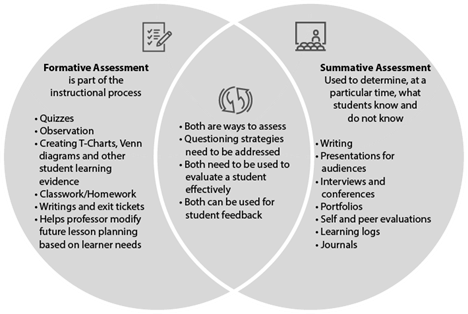Formative Assessments
Description:
Formative assessment is the process of checking for understanding so that instructors and students are able to see what they know and do not know. Formative assessments take place during instruction, while summative assessments take place after instruction. Instructors can utilize data from formative assessments to provide supplemental instruction or resources so that students are adequately prepared for summative assessments.

Instructional Uses:
- Assign a practice quiz in D2L or another platform so that students can gauge their understanding of course concepts.
- Check for understanding through the lesson using student response systems such as Poll Everywhere and Socrative.
- Have students submit an exit slip (in person or electronically through D2L Surveys
or Qualtrics) that answers questions such as:
- What did I learn in this module/class?
- What did I find interesting in this module/class?
- Questions I still have about content from this module/class.
- Utilize the Q&A board in Zoom to allow students to ask questions during synchronous sessions. For face to face courses, you can utilize backchannels such as Mentimeter.
WCU Supported Tools:
Additional Tools:
Tips for using Formative Assessments:
- Focus formative assessments less on responses and more on performance and application of learning into realistic situations.
- Structure assessments that will empower students to be self-regulated learners and allow them to apply feedback to their learning.
- Student Response Systems offer a flexible tool for teaching as they can be used with a variety of questions, student groups and academic settings. They also create an active learning environment with a peripheral or central role during the class.
References:
Boston, C. (n.d.). The Concept of Formative Assessment. Retrieved from https://eric.ed.gov/?id=ED470206
Buzzetto-More, and Alade, A.J. (2006). Best Practices in e-Assessment. Journal of Information Technology Education: Research, 251-269. Informing Science Institute.
Caldwell, J. E. (2007). Clickers in the Large Classroom: Current Research and Best-Practice Tips. CBE—Life Sciences Education,6(1), 9-20. doi:10.1187/cbe.06-12-0205
